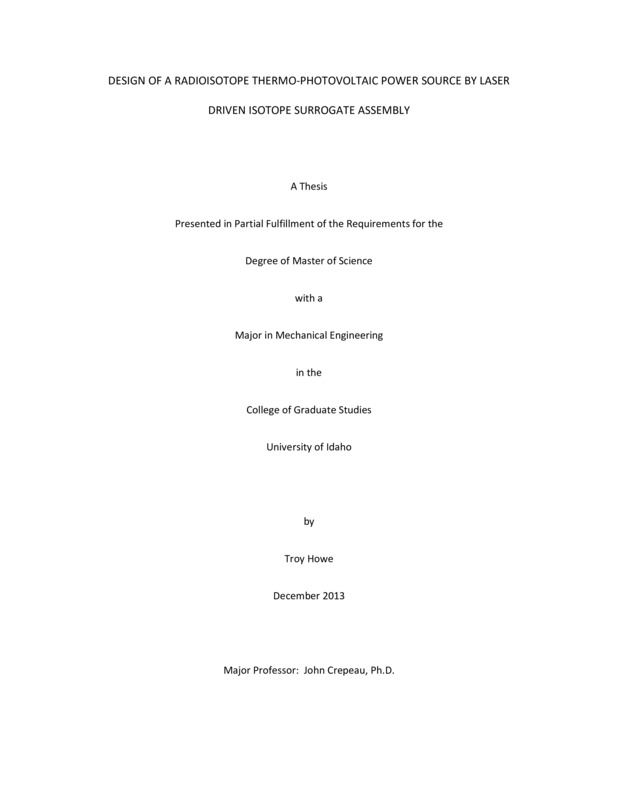DESIGN OF A RADIOISOTOPE THERMO-PHOTOVOLTAIC POWER SOURCE BY LASER DRIVEN ISOTOPE SURROGATE ASSEMBLY
Howe, Troy. (2013). DESIGN OF A RADIOISOTOPE THERMO-PHOTOVOLTAIC POWER SOURCE BY LASER DRIVEN ISOTOPE SURROGATE ASSEMBLY. Theses and Dissertations Collection, University of Idaho Library Digital Collections. https://www.lib.uidaho.edu/digital/etd/items/howe_idaho_0089m_10060.html
- Title:
- DESIGN OF A RADIOISOTOPE THERMO-PHOTOVOLTAIC POWER SOURCE BY LASER DRIVEN ISOTOPE SURROGATE ASSEMBLY
- Author:
- Howe, Troy
- Date:
- 2013
- Keywords:
- Photovoltaic Power generation Radioisotope RTPV Satellite Space
- Program:
- Mechanical Engineering
- Subject Category:
- Mechanical engineering
- Abstract:
-
Thermo-photovoltaic (TPV) technologies have the potential to benefit a very important aspect of space exploration technology: the conversion of heat into electricity. A thermo-photovoltaic device uses a very hot source material which emits photons through radiative heat transfer and a photovoltaic (PV) cell to pick up that radiation to turn it into electricity via the photovoltaic effect [1]. The energy of emitted photons must match or surpass the band gap of the PV cell to function, and if properly tuned, quantum efficiencies of over 95% can be achieved [2]. A radioisotope thermo-photovoltaic (RTPV) uses a radioisotope as the heat source to achieve these high temperatures, as well as provide power over the course of decades. Given these potentially high efficiencies, long life spans, and lack of moving parts, RTPV technologies are ideal for space exploration situations where missions may take longer than 20 years to complete. Additionally, development in this area could contribute to alternative fuel cars [3], terrestrial power generation [4], or power sources in hostile environments.
The major aspects to investigate in TPV technology include the conductive heat losses through the mounting systems and the tuning of the emitter material to the PV band gap. For the heat loss aspect, a model was built in COMSOL and used to trace conductive losses through a model of an RTPV system. For the emissivity tuning aspect, facilities at the Idaho National Laboratory were used to develop a laser heated emissivity testing facility. The computer model was used to corroborate the experimental data and material properties, and an RTPV system was designed based on experimental results and computational modeling.
Based on the experimental data, the theoretical model would need to be much larger than initially planned to reach a functioning temperature. The emissivity of the tantalum emitter material increased with temperature, and the power input of the radioisotope source was insufficient to keep temperatures high. Therefore, a larger power-to-emissive area was necessary. As the volume of the fuel rod increased, the emitting surface area also increased, but at a slower rate. So using more fuel would raise the maximum operating temperature.
The result of the project produced a testing device that could simulate a solid fuel power source for radioisotope thermophotovoltaic uses. Only a tantalum emitter surface was tested, but other materials could be used to improve emissive profiles in the future. Maximum testing temperatures reached 779 K, with optimized mounting systems and target properties. The final theoretical design was found to have external dimensions of 14.48 cm height by 12.7 cm diameter, not counting radiators. It used 1000 W of thermal power to generate 60W of electrical power, and reached a maximum temperature of 1200 K. This performance matched the efficiency and specific power of current thermoelectric generators. Further improvements to RTPV systems in the areas of selective emitters and maximum temperature increases will improve performance and make RTPV systems a preferred candidate for space power production.
- Description:
- masters, M.Engr., Mechanical Engineering -- University of Idaho - College of Graduate Studies, 2013
- Major Professor:
- Crepeau, John
- Committee:
- Steciak, Judith; Kanakala, Raghunath
- Defense Date:
- 2013
- Identifier:
- Howe_idaho_0089M_10060
- Type:
- Text
- Format Original:
- Format:
- application/pdf
- Rights:
- In Copyright - Educational Use Permitted. For more information, please contact University of Idaho Library Special Collections and Archives Department at libspec@uidaho.edu.
- Standardized Rights:
- http://rightsstatements.org/vocab/InC-EDU/1.0/

